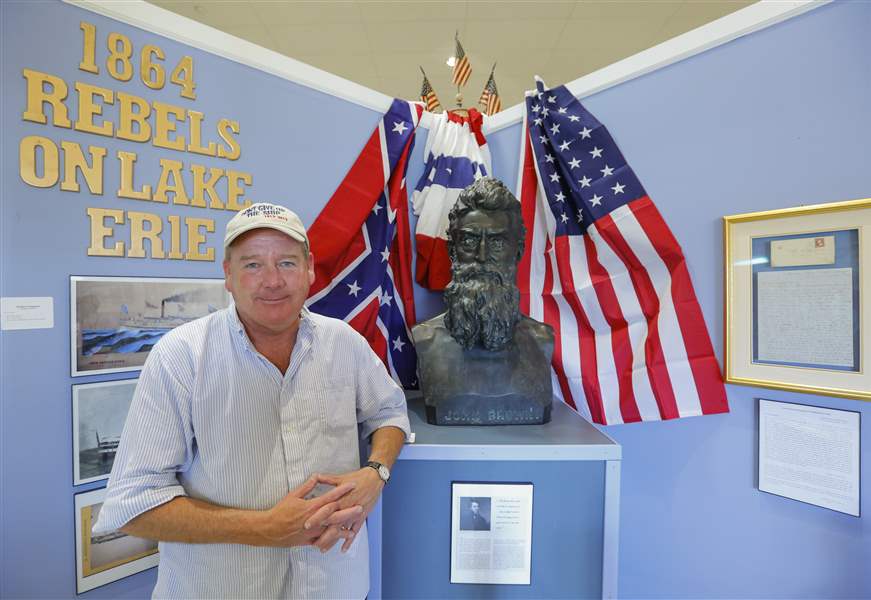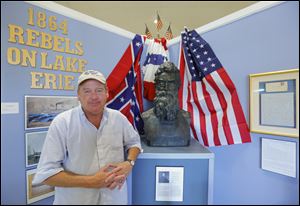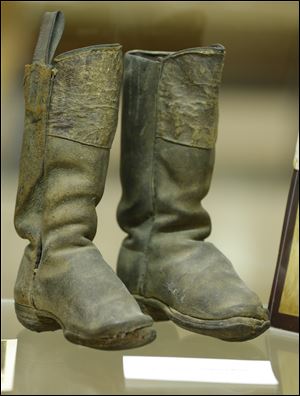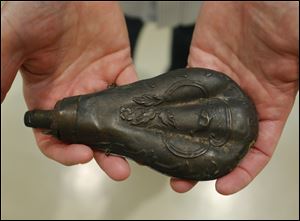
Lake Erie Islands Historical Society exhibit looks back at Civil War
7/27/2014
Dan Savage stands near a sculpture of abolitionist John Brown at the Lake Erie Islands Historical Society.
The Blade/Andy Morrison
Buy This Image

Dan Savage stands near a sculpture of abolitionist John Brown at the Lake Erie Islands Historical Society.
PUT-IN-BAY -- Dan Savage talks about the “1864: Rebels on Lake Erie” exhibit at the Lake Erie Islands Historical Society with such enthusiasm that a visitor hardly notices how modest the exhibit is. Mr. Savage, the museum‘s director, says the collection’s importance lies in what it reveals about Northwest Ohio's role in the Civil War.
Although he said “it's not a grand show, but a humble show,” you can't tell that from the large outdoor signage announcing it to everyone getting off the ferry at Put-in-Bay. Nevertheless, it's very much worth making the trip to the island to see this particular exhibit and other museum artifacts that tell of the area's role in the nation's history.
One of the first items a visitor sees upon entering the museum is the nearly three-foot-tall bust of John Brown, the abolitionist behind the raid on Harper's Ferry in 1859. Brown's son and namesake, John Brown, Jr., probably knew about his father's plans, but he was not involved in the futile attempt to overthrow slavery by arming slaves and other abolitionists with arsenal from the federal armory in Virginia.
Nevertheless, John Brown, Jr.'s residency on the island – he moved there in 1862 – proved to be crucial, at least for the Union, in the war's turn of events. His fast action thwarted privateer John Yates Beall's effort to free Confederate prisoners on nearby Johnson's Island.
Summarizing the 1864 event that, had it been successful, could have changed the outcome of the war in Ohio, Mr. Savage said Beall – a wealthy Virginian – sailed with Confederate sympathizers from Detroit, hijacked a ferry, and headed toward Johnson's Island.
History records that Brown, Jr., and other islanders learned that Beall had hijacked the Philo Parsons and the Island Queen, and that they aimed to take the gunboat, U.S.S. Michigan, too. The rebels were bound for Johnson's Island to free the imprisoned Confederate officers.

Brown family children's boots at the Lake Erie Islands Historical Society.
Brown, Jr., led the way to warn prison guards about the plans, and a major feat it was, considering that he lacked the technology we're so familiar with today. Brown and his peers rowed Lake Erie in the dark of night, then made made the trek to the prison camp, effectively thwarting Beall's goal.

A Civil War powder horn owned by Charles J. Linskey, first mayor of Put-in-Bay and the island doctor, at the Lake Erie Islands Historical Society. It was dented when he was shot off his horse on Sherman's March to the Sea.
Museum visitors will see a pair of children's boots that belonged in the Brown family, Brown Jr.'s traveling munitions case, and a wooden cane inscribed with his name and topped off with a watch face.
Other artifacts include the dented Civil War powder horn that belonged to Charles Linskey, Put-in-Bay's island doctor and its first mayor. Mr. Savage said the item was dented when Linskey was shot off his horse during Sherman's march to the sea.
The Colt revolver on display belonged to Col. Charles W. Hill, who was also commander of the Johnson's Island Prisoner of War Depot. The Civil War drum was Lucius Deming's, of Co. A, 128th O.V.I.: the 128th regiment of the Ohio volunteer infantry.
This exhibit and much more at the Lake Erie Islands Historical Society Museum will likely make anyone with a cursory grasp of history want to learn more.
The show will run through Oct. 1. The museum is open daily from 11 a.m. to 5 p.m. Cost to see the exhibit is $3 per person. It is free for veterans and active military personnel.
Meanwhile, the island historical society's annual charity auction is set for Aug. 9 beginning at 4 p.m. Lake Erie memorabilia, antiques, and collectibles are among the items up for auction. Proceeds will benefit the museum.
Further information is available by calling the museum at 419-285-2804 or visiting its website, at leihs.org.
Contact Rose Russell at 419-724-6178 or rrussell@theblade.com.